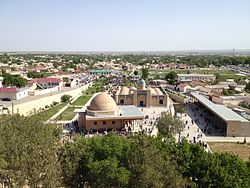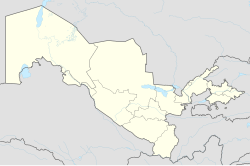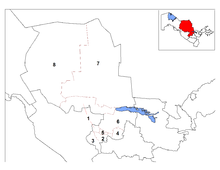Nurota
|
Nurota Нурота |
||
|
Nurota pilgrimage center, the city in the background |
||
| Basic data | ||
|---|---|---|
| State : |
|
|
| Province: | Navoiy | |
| District: | Nurota | |
| Coordinates : | 40 ° 34 ' N , 65 ° 41' E | |
|
|
||
| Height : | 490 m | |
| Residents : | 30,941 (2009) | |
| Telephone code : | (+998) 436 | |
Nurota ( Cyrillic Нурота ; Russian Нурата Nurata ) is a city in the Uzbek province of Navoiy , located in an oasis in the Kyzylkum desert , 75 km northeast of the city of Navoiy at about 490 m above sea level. According to the 1989 population census, Nurota had 21,000 inhabitants at that time, according to a calculation for 2009 the population is 30,941. Nurota is the capital of the Nurota district of the same name .
Nurota is known as a destination for religious pilgrims and for its ancient suzani . The Karez irrigation system is important around Nurota .
history
Nurota, formerly known as Nur , was born in 327 BC. Founded by Alexander the Great . Alexander's troops are said to have prepared for the storm on Samarqand in the fortress from that time in the south of today's Nurota . At that time, the fortress was located at a strategically important point at the transition from the agricultural area to the wild steppe.
Nurota was a destination for Muslim pilgrims as early as the 10th century .
At the beginning of the 18th century, the Bukhara Khanate , to which the city belonged, weakened and the local rule of the Burqut emirs became more visible.
Tourism and sightseeing
The ruins of Alexander's fortress, which is one of the oldest and most important archaeological monuments in the region, are still enthroned above Nurota. The bronze age petroglyphs of Zukarnay can be found four kilometers from the fortress .
Below the fortress is a spring ( Persian چشمه Tschaschma , "source"). The mineral-rich water of the spring and the fish swimming in it are considered sacred, as the spring - according to belief - came into being when Ali ibn Abi Talib struck his staff into the earth here. The spring and the sacred buildings surrounding it - including a domed mosque from the 10th century - are a pilgrimage center .
The nearby Nuratau Mountains and Lake Aydar to the northeast are the center of emerging Uzbek ecotourism . There are some yurt camps around Nurota .
Individual evidence
- ↑ Page no longer available , search in web archives: bevoelkerungsstatistik.de
- ↑ a b c d Bradley Mayhew, Greg Bloom, John Noble, Dean Starnes: Central Asia . Lonely Planet, 2007. ISBN 1741046149 ; P. 235f
- ↑ a b c d e advantour.com
- ^ A b Klaus Pander: Central Asia . DuMont Reiseverlag, 2005. ISBN 3770136802 ; P. 197
- ^ Jürgen Paul : Central Asia . Frankfurt am Main 2012 ( Neue Fischer Weltgeschichte , Volume 10), pp. 357/58



